Ever catch yourself sighing heavily after a killer workout, feeling like your muscles are screaming for mercy?
You know that achy, tight feeling that makes climbing stairs a monumental challenge?
We’ve all been there, pushing our bodies to the limit. But what if I told you that your post-workout recovery is just as important as the workout itself?
And what if the key to faster recovery was something you already have with you – your breath?
While many reach for protein shakes or ice baths, there’s a simple, science-backed technique that can revolutionize your workout recovery – Deep Breathing For Workout Recovery.
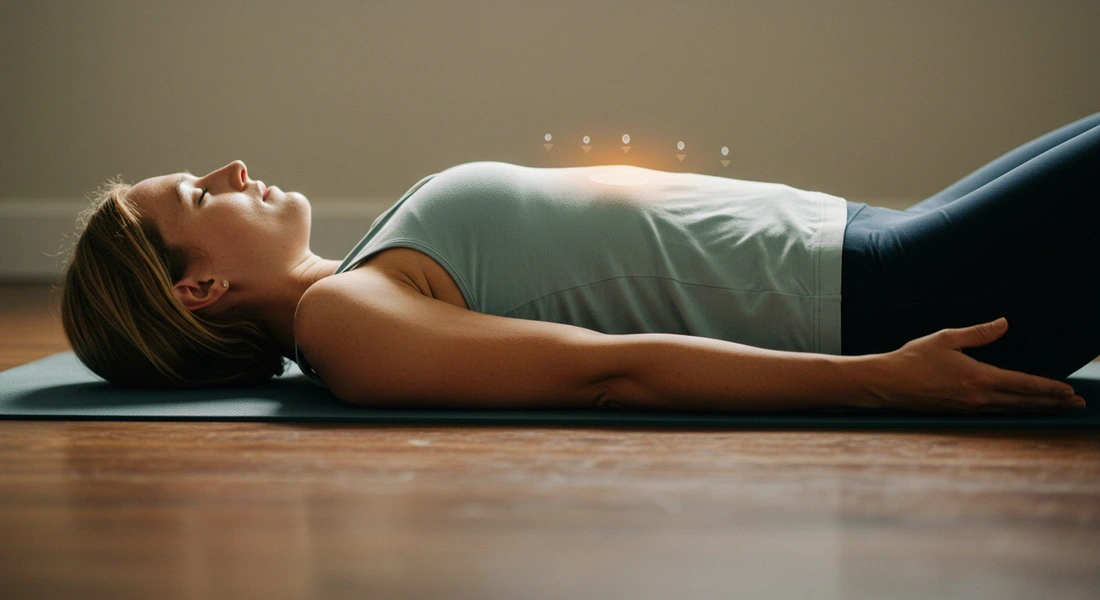
This technique accelerates muscle repair, reduces soreness, and gets you back to feeling your best, faster.
In this ultimate guide, you’ll learn the secrets of deep breathing, unlocking its incredible potential for faster healing and peak performance.
Get ready to breathe your way to a better recovery!
The Science of Deep Breathing for Workout Recovery
So, deep breathing sounds great, right?
But how does it actually help your muscles recover?
It’s not just about feeling relaxed (although that’s a bonus!).
Deep breathing triggers a cascade of positive physiological effects that directly impact your recovery process:
Improved Oxygen Delivery to Muscles
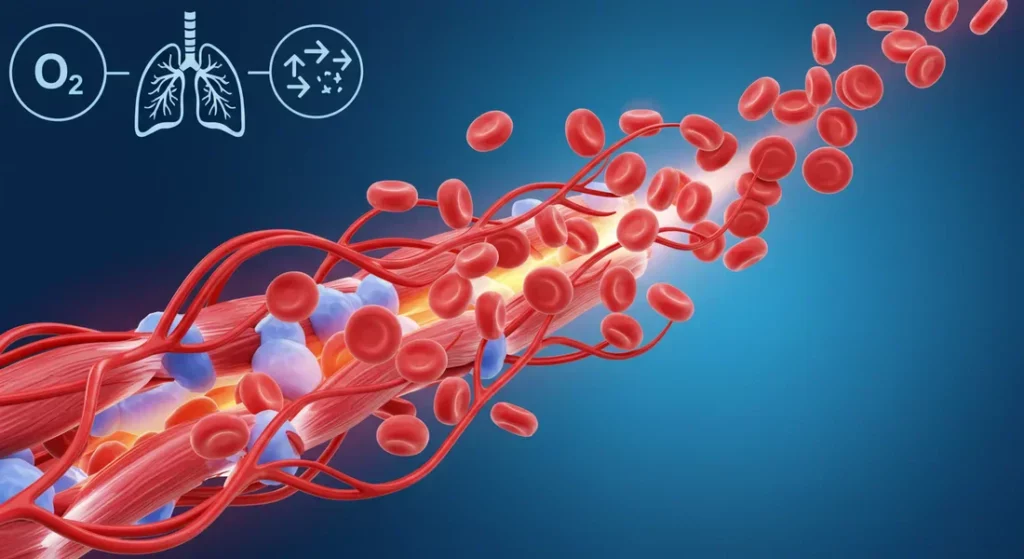
Think of oxygen as fuel for your muscles’ repair crew. After a tough workout, your muscles are working overtime to rebuild and recover. Deep breathing increases the amount of oxygen circulating in your bloodstream, ensuring that your muscles have the fuel they need to do their job effectively. It’s like giving them a supercharged boost!
(Citation: Study on deep breathing and oxygen saturation)
Reduced Inflammation
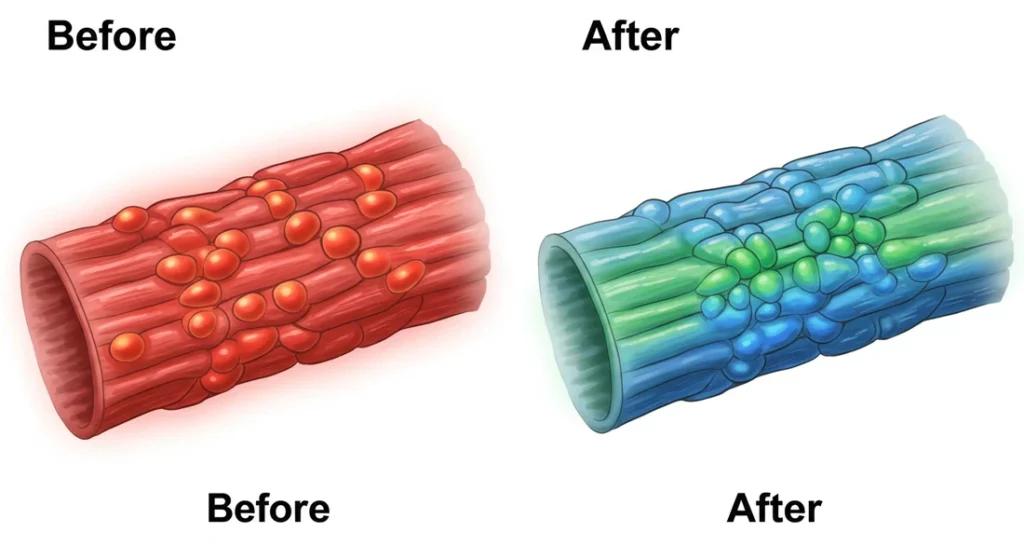
Inflammation is a natural response to exercise-induced muscle damage, but too much inflammation can hinder recovery. Deep breathing activates your parasympathetic nervous system (your ‘rest and digest’ system), which helps to regulate the inflammatory response, preventing it from becoming excessive and allowing your muscles to heal more efficiently.
(Citation: Study on breathing and inflammation markers)
Lowered Cortisol Levels
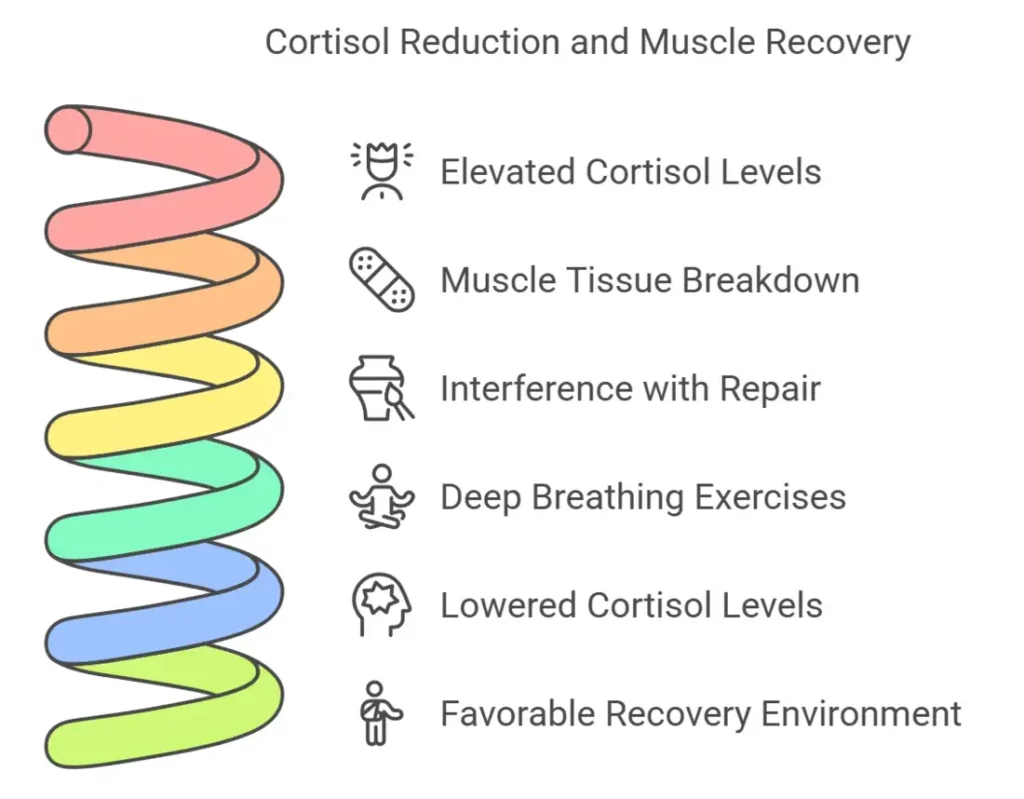
Cortisol, the stress hormone, can wreak havoc on your recovery efforts. Elevated cortisol levels can break down muscle tissue and interfere with the repair process. Deep breathing exercises have been shown to lower cortisol levels, creating a more favorable hormonal environment for muscle recovery.
(Citation: Study on deep breathing and cortisol levels)
Enhanced Parasympathetic Nervous System Activity
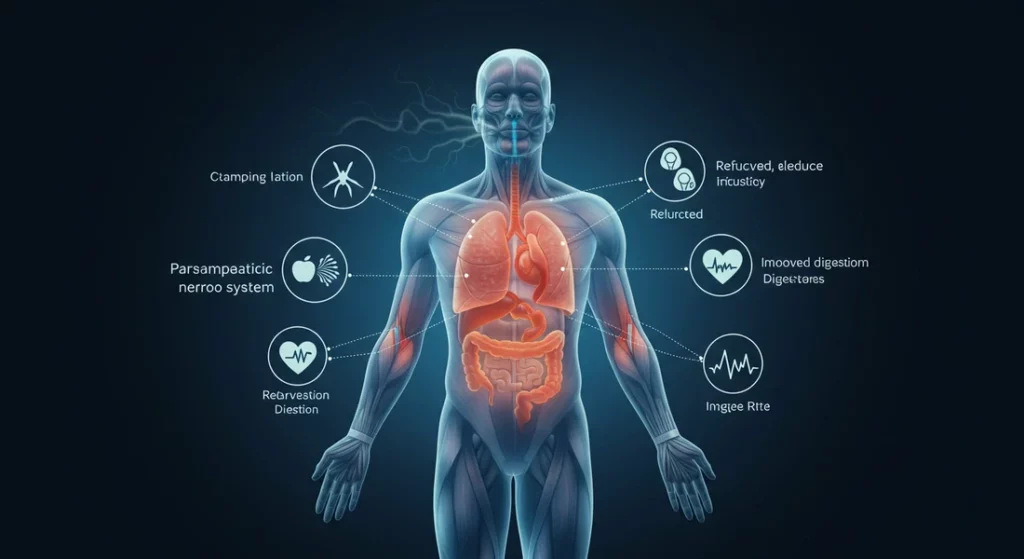
Your parasympathetic nervous system (PNS) is your body’s built-in recovery system. It promotes relaxation, reduces heart rate, and stimulates digestion – all crucial for optimal recovery. Deep breathing is a powerful way to activate your PNS, shifting your body out of ‘fight or flight’ mode and into ‘rest and repair’ mode.
(Citation: Study on deep breathing and parasympathetic nervous system activity)
Improved Lymphatic Drainage
The lymphatic system helps remove waste products and toxins from your body. Deep breathing helps to stimulate lymphatic drainage, flushing out metabolic waste from your muscles and reducing swelling and stiffness. It’s like giving your muscles a detoxifying cleanse!
(Citation: Study on deep breathing and lymphatic drainage)
Key Takeaway:
Deep breathing isn’t just about relaxation; it’s a scientifically proven way to optimize your body’s recovery mechanisms.
Deep Breathing Techniques for Faster Recovery
Ready to put the science into practice? Here are 5 deep breathing techniques you can use to accelerate your workout recovery:
1. Diaphragmatic Breathing (Belly Breathing)
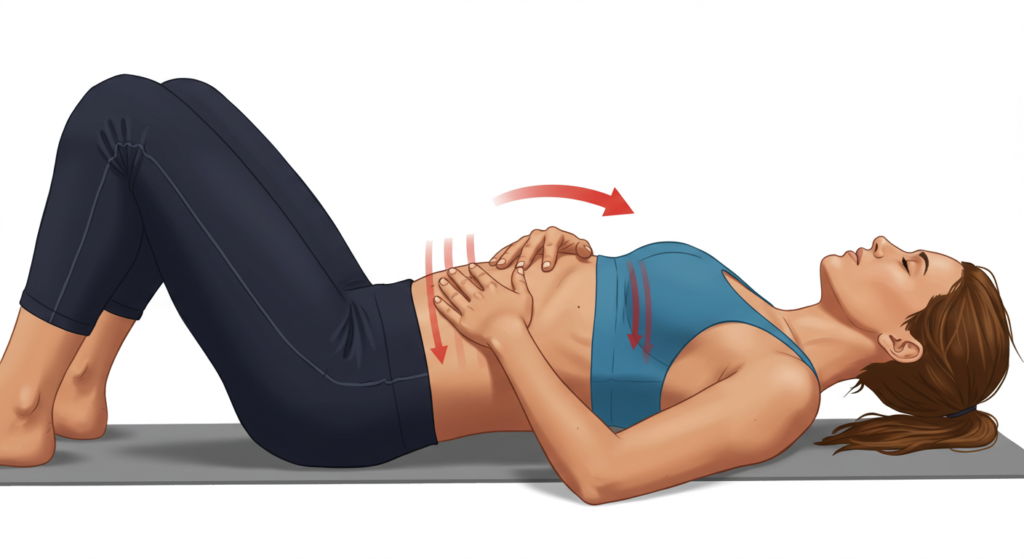
This is the foundation of deep breathing and a must for workout recovery.
It promotes relaxation, improves oxygen flow, and reduces stress.
Steps:
- Find a comfortable position: Lie on your back with your knees bent, or sit comfortably.
- Place your hands: One hand on your chest, the other on your belly.
- Inhale deeply: Slowly inhale through your nose, focusing on expanding your belly. Your chest should remain relatively still.
- Exhale slowly: Exhale gently through your mouth, allowing your belly to fall.
- Repeat: Continue for 5-10 minutes, focusing on the rise and fall of your belly.
- Timing: Immediately post-workout, before bed.
- Benefits: It promotes relaxation, improves oxygen flow, and reduces stress.
2. Box Breathing
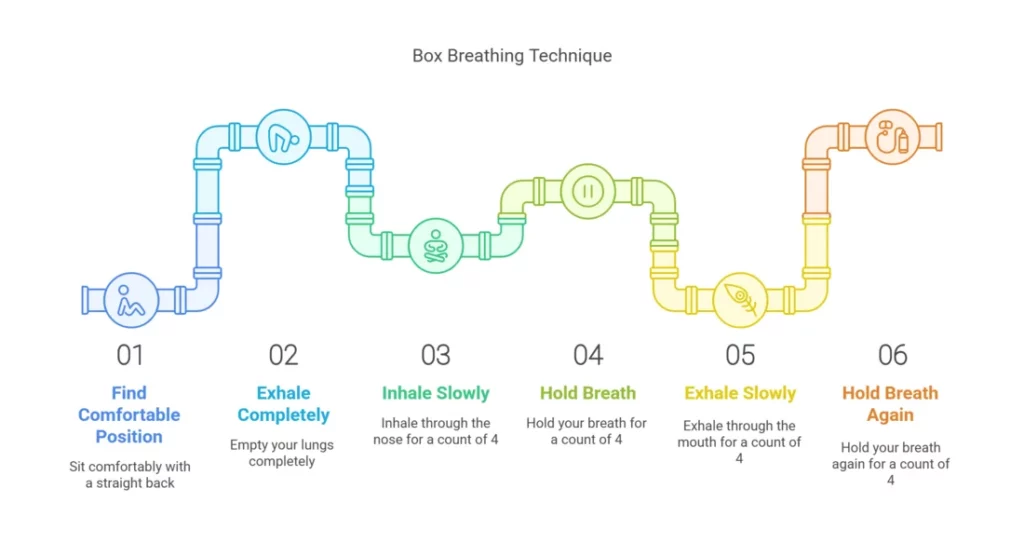
This technique promotes relaxation, improves focus, and calms down the nervous system.
Steps:
- Find a comfortable position: Sit straight with your feet on the ground.
- Inhale slowly: Inhale through the nose as you count to 4 slowly.
- Hold the breath: Count slowly to 4.
- Exhale slowly: Exhale fully through the mouth as you count slowly to 4.
- Rest: Maintain the state as you count to 4.
- Timing: Anytime after workout, especially if you are feeling stressed out.
- Benefits: Promotes relaxation, improves focus, and calms down the nervous system.
3. Pursed-Lip Breathing
Improve oxygen exchange and reduces breathlessness.
Steps:
- Relax: Neck and shoulders.
- Inhale: Through the nose.
- Exhale: Slowly through pursed lips as if you were whistling.
- Repeat: 5-10 minutes.
- Timing: While you are cooling down.
- Benefits: Improve oxygen exchange and reduces breathlessness.
4. Alternate Nostril Breathing:
This technique focuses on improving mind-body connection.
Steps:
- Sit down straight and comfortably.
- Use the right thumb to close the right nostril.
- Inhale through the left nostril.
- Release the right nostril and close the left nostril as you exhale.
- Inhale through the right nostril.
- Release the left nostril and close the right nostril as you exhale.
- Repeat 5-10 minutes.
- Timing: When you want to focus.
- Benefits: Improves focus.
5. 4-7-8 Breathing
A technique that relaxes and calm the nervous system.
Steps:
- Place the tip of the tongue behind the upper front teeth.
- Exhale completely through the mouth.
- Close the mouth as you inhale through the nose. Count to 4.
- Hold the breath and count to 7.
- Exhale through the mouth, purse the lips and count to 8.
- Repeat 5-10 minutes.
- Timing: Before sleep.
- Benefits: Relaxing before sleep.
How to Create a Deep Breathing Recovery Routine
Now that you know the science and the techniques, let’s create a personalized deep breathing recovery routine that fits your lifestyle.
Here’s how:
- When to Practice:
- Immediately After Your Workout: During your cool-down, dedicate 5-10 minutes to deep breathing.
- Throughout the Day: Practice deep breathing during breaks, before meals, or anytime you feel stressed.
- Before Bed: Deep breathing before sleep can promote relaxation and improve sleep quality.
- How Often to Practice:
- Consistency is key! Aim for at least 5-10 minutes of deep breathing per day, every day.
- You can break this up into multiple sessions throughout the day.
- Where to Practice:
- Find a quiet and comfortable space where you won’t be disturbed.
- You can practice anywhere: at home, at the gym, outdoors, or even in your office.
- Combining with Other Recovery Methods:
- Stretching: Combine deep breathing with gentle stretching to further reduce muscle tension and improve flexibility.
- Hydration: Drink plenty of water to help flush out toxins and support muscle recovery.
- Nutrition: Consume a balanced diet with plenty of protein and carbohydrates to fuel muscle repair.
- Sleep: Prioritize getting 7-9 hours of quality sleep per night to allow your body to fully recover.
- Foam Rolling: Combine deep breathing with foam rolling to release muscle knots and improve blood flow.
Example Routine:
5 Minutes After Workout: Diaphragmatic Breathing
During lunch: Box Breathing
Before Bed: 4-7-8 Breathing
Action: Experiment and find what works for you.
Troubleshooting Common Problems
Starting a new habit is not easy, but here are a few common problems and how to troubleshoot them,
- Feeling Dizzy or Lightheaded:
- Problem: Deep breathing can sometimes cause dizziness or lightheadedness, especially when you’re first starting out.
- Solution: Slow down your breathing, and reduce the depths of your breaths. If you start feeling dizzy, stop and rest for a few minutes. As you become more comfortable with deep breathing, the dizziness should subside.
- Difficulty Focusing:
- Problem: You may find it difficult to focus on your breath, especially if you have a busy mind.
- Solution: Start with short sessions. Try practicing in a quiet environment. You can also try using a guided meditation app to help you focus.
- Not Seeing Results:
- Problem: You might not be seeing noticeable improvements in your workout recovery.
- Solution: Be patient and persistent. Deep breathing takes practice and consistent efforts. Make sure you are combining deep breathing with other recovery methods and are following a healthy lifestyle.
- Feeling Anxious and Irritated:
- Problem: It is not uncommon to feel anxious and irritated during any type of exercise.
- Solution: As you continue and be persistent you will start to find patterns, like, knowing what is going to happen, and you will be able to feel calm and composed to start a regime of new habits.
Beyond the Gym – The Ripple Effects of Deep Breathing
The beauty of deep breathing is that its benefits extend far beyond just your workout recovery.
By incorporating these techniques into your daily life, you may also experience:
- Stress Reduction:
- Deep breathing activates your parasympathetic nervous system, which promotes relaxation and reduces stress hormones.
- Improved Sleep:
- Practicing deep breathing before bed can help calm your mind and improve the quality of your sleep.
- Enhanced Mental Clarity:
- Deep breathing improves oxygen flow to the brain, which can enhance focus, concentration, and mental clarity.
Resources and Tools
Want to take your deep breathing practice to the next level?
Here are some helpful tools and resources to consider:
Breathing Apps
- Breathe+: This simple app provides guided breathing exercises directly on your phone, making it easy to practice anywhere, anytime. It’s perfect for beginners and those looking for a quick and convenient way to incorporate deep breathing into their daily routine.
- Prana Breath: This app offers a variety of breathing exercises and techniques to help improve and control your breath. It includes customizable settings, progress tracking, and personalized recommendations.
Breathing Devices
- Expand-A-Lung: This device helps improve respiratory strength and lung capacity by providing resistance during inhalation. It’s a great option for athletes and those looking to enhance their overall respiratory fitness.
- POWERbreathe: Similar to Expand-A-Lung, POWERbreathe provides resistance during inhalation, strengthening your breathing muscles and improving lung function. It’s used by athletes, singers, and individuals with respiratory conditions.
Other Resources
- Online Videos: YouTube and other video platforms offer a wealth of guided breathing exercises and tutorials. Search for videos that are led by qualified instructors and that align with your specific goals.
- Books: Explore books on pranayama (yogic breathing techniques) and other breathing methods to deepen your understanding and expand your practice.
- Local Yoga Studios: Many yoga studios offer classes that incorporate breathing techniques (pranayama). Taking a class with a qualified instructor can provide personalized guidance and support.
Frequently Asked Questions
- Q: I don’t have time, can the breathing be only done before bed?
- A: Spreading the breathing out is preferable, although only before bed is better than none, try to fit it somewhere in the day.
- Q: What if I fall asleep when I am doing the breathing?
- A: Don’t do the process before sleep in case you fall asleep in the process, safety is key.
- Q: I don’t feel any different when I finish, is it working?
- A: Breathing effects can be subtle, this does not mean it isn’t working, remember to be consistent.
- Q: What are the other ways breathing can assist the body?
- A: Breath-work assists with blood flow, mental clarity, and can stimulate the vagus nerve.
Conclusion – Take a Breath, Take Control of your Recovery
Deep breathing is a powerful tool for improving your workout recovery.
By incorporating these techniques into your routine, you can enhance your muscle repair, reduce inflammation, and optimize your performance.
Ready to feel the difference?
Start practicing deep breathing today and unlock your body’s natural healing potential!
Ready to start feeling better today!
Download the cheatsheet to learn more!
Related Posts
No posts
